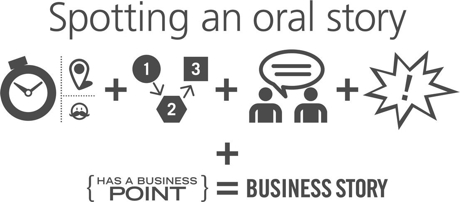Blog
Subscribe
Join over 5,000 people who receive the Anecdotally newsletter—and receive our free ebook Character Trumps Credentials.
Categories
- Anecdotes
- Business storytelling
- Collaboration
- Communication
- Corporate Storytelling
- Culture
- Decision-making
- Employee Engagement
- Events
- Fun
- Insight
- Leadership Posts
- News
- Podcast
- Selling
- Strategy
Archives
- March 2024
- December 2023
- November 2023
- October 2023
- September 2023
- August 2023
- July 2023
- June 2023
- May 2023
- April 2023
Years
Stories don’t need conflict and resolution, or a hero for that matter

It seems that everyone is giving advice about stories and storytelling these days. And it irks me every time I hear a story ‘expert’ say that a story must have conflict and resolution. Really?
Take this morning’s offering from Copyblogger.com, which lists 5 reasons to use stories. Number 2 says,
Stories have conflict and resolution. This structure creates suspense and holds readers’ attention.
Whenever I hear something like this I immediately think of the exception, which for me is the coincidence story. I’ve talked about this before but at the risk of repeating myself too much a coincidence story is just when something happens that’s remarkable; it’s unlikely. People love coincidence stories. This American Life dedicated a whole show to them with the title, No Coincidence, No Story.
And it’s worth knowing that a coincidence story doesn’t have a hero. Hmmm, I thought stories must have a hero, facing a challenge. We are way too influenced by Hollywood. When you listen to stories told in organisations you get a whole new perspective.
Now, here’s the bare minimum you need to know to spot an oral story. I say oral story because that’s what we mainly work with at Anecdote. This is a fundamental skill for any narrative work.

Time marker, place marker or character: stories start in one of these three ways but orally they mostly start with time markers. So if you hear someone say, “On Tuesday …” or “A while back …” or “In 1991 …” there is a good chance you will hear a story.
Events: stories are about something happening; this event followed this event, which followed that event. Good stories help you see and feel what’s happening.
People: if you hear people’s names, and in particular if you hear dialogue, then you know you are in a story.
Unanticipated: A story is a promise to the listener that they will learn something new. It has to have something that is at least a little unexpected.
Now, to make it a business story is has to have a business point. You might even preface the story with the point, such as “To succeed in sales you really have to care.” Then you tell your story that illustrates what you mean.
About Shawn Callahan
Shawn, author of Putting Stories to Work, is one of the world's leading business storytelling consultants. He helps executive teams find and tell the story of their strategy. When he is not working on strategy communication, Shawn is helping leaders find and tell business stories to engage, to influence and to inspire. Shawn works with Global 1000 companies including Shell, IBM, SAP, Bayer, Microsoft & Danone. Connect with Shawn on:
Comments
Comments are closed.
Yes! How many stories are tossed away because there is no “hero?” I really like what you are saying here. Great stuff! Thank you!